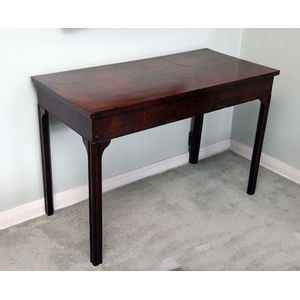Antique Oak Writing Table with Lyre-Shaped End
You must be a subscriber, and be logged in to view price and dealer details.
Subscribe Now to view actual auction price for this item
When you subscribe, you have the option of setting the currency in which to display prices to $Au, $US, $NZ or Stg.
- Lyre Motif - The lyre motif is an ancient decorative design that is believed to have originated in ancient Greece, where the lyre was a popular musical instrument. The lyre itself was often decorated with ornate carvings and designs, including the iconic lyre motif.
In ancient Greek mythology, the lyre was associated with the god Apollo, who was the patron of music and the arts. The lyre was said to have been invented by the god Hermes, who presented it to Apollo as a gift. As a result, the lyre became a symbol of creativity, inspiration, and artistic expression.
The lyre motif typically features a curved or S-shaped body, with strings extending upwards from the base. The motif was often used in architectural decoration, as well as on pottery, jewellery, and other decorative objects. - Oak - Native to Europe and England, oak has been used for joinery, furniture and building since the beginning of the medieval civilisation. It is a pale yellow in colour when freshly cut and darkens with age to a mid brown colour.
Oak as a furniture timber was superceded by walnut in the 17th century, and in the 18th century by mahogany,
Semi-fossilised bog oak is black in colour, and is found in peat bogs where the trees have fallen and been preserved from decay by the bog. It is used for jewellery and small carved trinkets.
Pollard oak is taken from an oak that has been regularly pollarded, that is the upper branches have been removed at the top of the trunk, result that new branches would appear, and over time the top would become ball-like. . When harvested and sawn, the timber displays a continuous surface of knotty circles. The timber was scarce and expensive and was used in more expensive pieces of furniture in the Regency and Victorian periods. - Lyre - Attributed to the 18th century designer Robert Adam, the back splat of a chair or sthe supports of a table are in the form of a lyre, a Greek musical instrument similar to a harp.
In shape it resembles two reversed scrolls.
Chairs continued to be made in this style for at least the next fifty years.
In Australia many cedar chairs and tables have survived dating to the 1830s and 1840s, featuring the lyre shape in the back splats and as supports for small tables.
This item has been included into following indexes:
Visually similar items

A Georgian mahogany pembroke table split to top 103 x 80 x 71

A George III mahogany serving table, circa 1780, of rectangular form on square chamfered legs.

An 18th century English side table, with plank top above a frieze drawer on square tapering supports, circa 1790. Provenance: John Dunn Antiques, Malvern. Receipts dated 1973. 70 cm high, 88 cm wide, 44 cm deep

A George III mahogany side table with moulded edge, above two frieze drawers on square tapering supporter in brass caps and castors, 122 cm long, 72 cm high, 59 cm deep. Provenance: Connoisseurs Store, Melbourne receipt dated 1/6/71 The Estate of Stanley C
